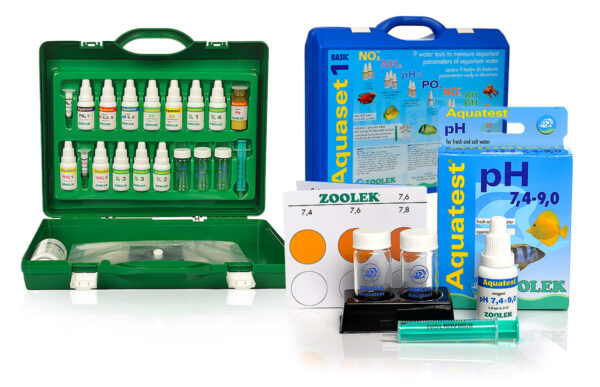Full control over water parameters in your aquarium
Calculator of water parameters in planted aquariums
Carry out measurements by means of Aquaset 2 flora or with Aquatests, then enter the results to obtain assessment of your water quality.
pH value is a measure of water reaction and one of the most important parameters in determining the possibility and conditions of healthy aquatic life. In freshwater aquariums its value depends mainly on carbonate, carbohydrate and carbon dioxide content as well as on the presence of other substances displaying acidic / alkaline properties such as humic substances and tannins. It should be taken into consideration that this parameter may fluctuate throughout the day due to life processes in organisms such as CO2 assimilation and breathing.
Carbonate hardness KH (alkalinity) is a measure of the buffering capacity of water and ability to stabilize pH favourable to aquarium organisms. Generally contributing to alkalinity are calcium and magnesium bicarbonates but in some aqueous media the presence of sodium and potassium bicarbonates also has the same effect. In planted aquariums a decrease in pH levels may occur under some conditions, as a result of e.g. CO2 deficiency or KH decrease caused by a substrate, which is why frequent checks of this parameter are necessary.
The content of dissolved carbon dioxide is especially important for plants using it in the process of photosynthesis. The optimal for plants concentration of CO2 should be kept in the range of 15 – 30 mg/l.
A nitrate concentration in the range of 5-40 mg/l is desirable for proper plant growth. These compounds are the final products of the waste protein conversion. In aquariums with fish the nitrate content is usually sufficient and the use of fertilizers containing nitrogen is not required. On the other hand, excess nitrates may contribute to rapid algae growth and becomes harmful to invertebrates and sensitive fish. As a result, frequent nitrate content checks using the Aquatest NO3 are essential.
To ensure proper plant growth phosphate concentration should be kept in the range of 0,25 – 1 mg/l. Generally, in fish tanks phosphate deficiency does not occur because it is introduced with food. Elevated phosphate levels are unfavourable as they contribute to rapid algae growth. Plant aquariums without fish or with low stocking density require the use of proper fertilizers containing nitrogen. Systematic measurements of phosphate concentration using the Aquatest PO4 make it possible to determine whether it is necessary to apply fertilizers containing phosphates
Potassium is one of the macroelements essential for proper plant growth. Each planted aquarium requires supplementation by means of fertilizers containing this element. Tap water doesn’t contain sufficient quantities of potassium nor is it delivered to an aquarium (as nitrogen and phosphorus) along with fish foods or other organic matter. Before supplementing water with potassium, a measurement with Aquatest K should be carried out. Proper potassium level should be kept in the range of 10-20 mg/l. A too high potassium concentration may disturb proper magnesium absorption.
Iron is an microelement vital for plant growth. The first sign of this element poor availability is leaves yellowing and then their dieback.
The value of GH is a measure of bivalent metal cations in water. In case of aquariums and natural waters they are mainly cations of calcium and magnesium. It should be taken into consideration that apart from their summed concentrations, the ratio of these two elements levels is also vital (especially for more demanding plants).
In natural waters the proportion of calcium to magnesium concentration varies depending on types of rock and minerals through which water flows. For aquariums with plants the range of 4:1 – 5:1 (Ca:Mg) is considered as a correct ratio. In practice, in case of most plants it is possible to use water with the ratio of calcium to magnesium concentration ranging from 2:1 to 12:1.
